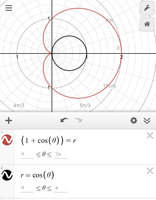KrabLord
New member
- Joined
- Jul 27, 2019
- Messages
- 38

So, the area of
[MATH] r = \cos(\theta) [/MATH]is found by taking
[MATH] \int_{0}^{\pi} \frac{1}{2} (\cos(\theta))^2 d\theta = \frac{\pi}{4} [/MATH]or by using the pi r^2 formula with r = 1/2.
So, and this is where my question begins, why is it that the integration boundaries are 0 and pi for cos(theta), yet for 1+cos(theta) we use 0 to 2pi?
